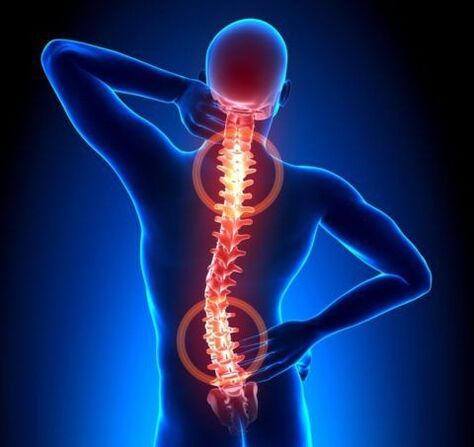
Many people in the age of 30-35 complained about back pain.The cause of these pain may be the disease of the spine.Osteochondrosis is a disease that occurs in middle -aged people, but is often detected in patients after 40 years.
Osteochondrosis - What is this disease and what is its danger?
This term means a chaotic process of cartilage and bone tissue.In modern medical practice, osteoporosis is called degenerative-degenerative disease of the spine and the interverteller disc play the role of shock absorbers.The risk of the disease is that the disk is almost impossible to recover, and there is no appropriate treatment, disability is possible.
Is Osteochondrosis a common disease?Not happy statistics.About 85% of the world's population suffered from this disease.
This disease is the most common form of all diseases that affect the spine.And according to the circulation rate, it is right after the disease of the cardiovascular system.
The nature of the disease
So, what is bones and joints?This is a chronic disease that affects the joints, usually spine.
The spine column consists of 24 vertebrae.Between the two vertebrae is a plate, its purpose is to soften and depreciate.
Under normal conditions, the disc is quite elastic and can withstand significant loads.In the center of the plate there is a pulp nucleus with lots of water.For some reasons, the core loses its water -loving properties.
As a result, the delay of disk, reducing height and deformation.In the later period, the growth of bone tissue occurs with the formation of growth - bone cells compressed peripheral nerves and spinal cord.This is what is osteoarthritis of the spine.
Causes of pathology
Despite the fact that osteoarthritis is a fairly common disease, the reason why the disease is not fully established.
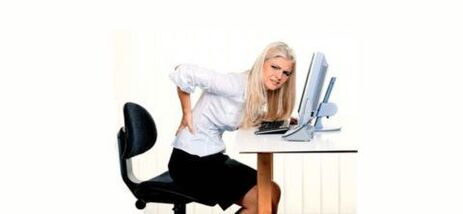
The main factors are considered:
- excessive load on the spine;
- injury;
- Professional harm - lifting weights or working for a long position, uncomfortable and immobile;
- excess body weight;
- hereditary;
- Breach of posture.
Osteochondrosis develops at one degree or another in most people of the elderly and is one of the aging processes of the body.
Stages, forms and symptoms of disease development
Experts distinguish 4 stages of the disease:
- Phase 1- Move the kernel of the disc to the edge;
- Phase 2- The appearance of cracks in cartilage wheels and the unstable vertebrae;
- Stage 3- A completely broken disk's break with nuclear loss in the spine body, while the root of the spinal cord is possible;
- 4th phase- Raw changes not only in Intervertebral disk, but also in surrounding fabrics.
The main symptom of the disease is pain.It can be acute with high intensity or stupid, moderate expression.
In addition to pain, there is:
- Pain stress of back muscles;
- paralysis of skin on arms and legs;
- Movement volume limit;
- Weaknesses in the muscles of Chi;
- thin arms and legs;
- Suddenly dizzy.
These are general manifestations for all forms of pathology.Depending on the spine in which the changes are located, the three diseases have distinguished symptoms.
Table 1. Forms of joints and their inherent symptoms:
| Form of disease | Symptom |
| Chemical fibrosis in the neck | The changes in this part lead to pushing blood vessels and microcirculation weakened.For this reason, a person is constantly dizzy.Sometimes this leads to fainting.There is noise in the ears and blink of the color spots before the eyes. |
| Bone fiber in the chest. | With this disease, acute chest pain is observed.The disease can cause the progression of intercostal nerve and worsen heart disease process. |
| Lumbar | The pathology in the lower back is manifested by pain in the Gluteal region, reducing the sound of IKR.A complication may be radiculite, accompanied by a widespread pain. |
Due to the pathology of the vertebrae, a large number of disorders in the body occur: pinching nerves, swelling, violations of circulation and fibrosis of surrounding tissues.These changes cause a variety of symptoms, complicated diagnosis and appropriate treatment prescription without careful testing.
Clinical manifestations
The symptoms of the disease depend on the location of the main lesion.In the following sections, we consider the typical signs of each disease.
Cervical part
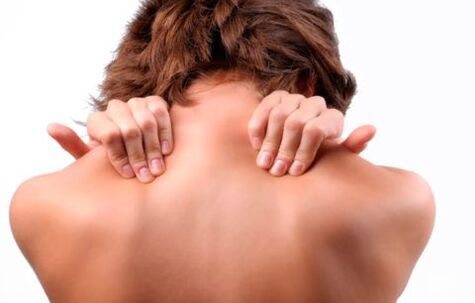
The main symptoms of cervical spine lesions include:
- discomfort, aches and pains in the neck and shoulders;
- muscle hypotonus;
- increase sweat;
- numbness of the finger;
- violating the coordination of movements;
- headache, dizziness;
- Hearing problems and vision;
- Hypertension.
With the progression of disease and damage to nearby arteries and nerves, one of the following can be developed:
- Vertebra artery;
- heart;
- hypertension;
- origin;
- Cervical migraine.
Violating blood circulation in the vertebral artery and the lack of oxygen of brain tissue are dangerous consequences of osteoarthritis.
This syndrome manifests:
- Periodic system/dizziness;
- weakening vision;
- Partial or complete hearing loss;
- Sometimes - fainting.
Important!The nerve manifestations of the osteoarthritis of the spine are often distinguished from atherosclerosis, dep and other diseases.
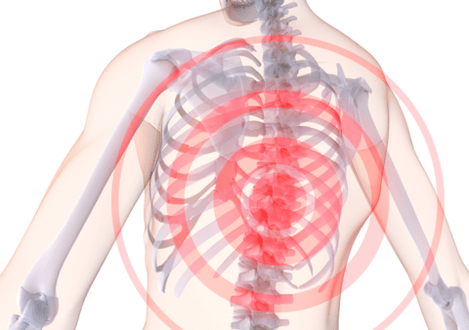
Chest
Compared to other forms of the disease, chest osteoarthritis is manifested less pronounced.
Among its symptoms:
- Chest pain, increased at night or prolonged in a position;
- Annoying, a feeling of tightening between shoulder blades;
- Enhance pain during deep breathing.
If the disease is not treated, it will progress, causing damage to nearby and the nerves nearby.
Signs of developing complications of osteoarthritis of this spine may be:
- paralysis of skin in some areas, the feeling of "goosebumps";
- Itchy, burning skin;
- Cooling limbs;
- The fragility of nails;
- Dry skin pronunciation;
- Pain along the esophagus and pharyngeal;
- Gastrointestinal disorders.
In addition, the chest localization of the disease is characterized by two specific symptoms - Dorsago and Dorsalgia.
Dorsago is a sudden, sharp and very intense chest pain, a change of breasts of Muslims.It can occur with prolonged in the same position, monotonous work.
Pay attention!During breast milk, the pain is so serious that the patient is even afraid of inhalation.
Dorsalgia is less intense, but monotonous pain can last up to 2-3 weeks.They enhance with deep breath, tendency.
Waistband
Osteochondrosis of the lower part of the spine, namely the belt, occupies the leading position in the circulation rate.
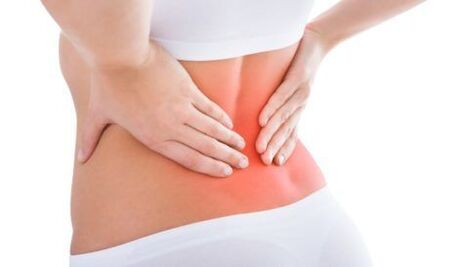
Among his typical symptoms:
- Dull, more often back pain, radiating on the legs;
- Uncomfortable, enhancing when changing the position of the body, sneezing, coughing, trying to lift weights;
- Constant muscle spasm on the lower back;
- Lights on the lower back;
- weakening the sensitivity on the skin of the buttocks, hips, legs, feet;
- A feeling of geese in the lower limb;
- Dry, flaky skin.
Sacral part
Osteochondrosis of the Sacral spine is extremely rare in isolation and is often a continuation of Muslims of lower lumbar lesions.
This explains the characteristics of his symptoms:
- Lower back pain, as well as in the nerve sealing;
- "Shelter" sharp through the entire leg;
- an unpleasant unpleasant feeling in the back of the thigh;
- numbness of the lower limb;
- Paresis, as well as the unstable symptoms of weakened motor activity.
Important!The lower osteochondrosis of the spine can lead to extremely dangerous complications when supplying blood weakened to the spinal cord and compressed marrow disease.
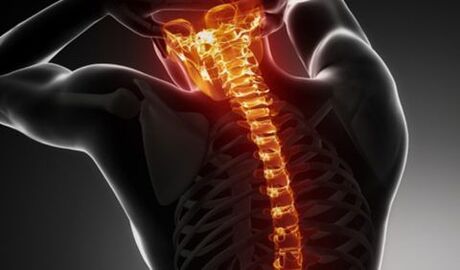
Common fibrosis
A common form, or osteoarthritis of all parts of the spine is the most serious version of the disease.Due to the great failure, its painting may be extremely diverse and include most of the symptoms described above.
Diagnostic method
The appearance of any complaint indicates above requires an appeal to a health organization: the patient must check the patient.Diagnosis of osteoarthritis must be complicated and very careful.
Standard guidelines include the following stages:
- Collection of complaints and Anamnesis.
- Clinical inspection.
- Check x -ray.
- Modern method (CT, MRI).
Performing a conversation with the patient, the doctor should find out:
- that disturb the patient;
- The place of the most obvious discomfort;
- What is their strength and time;
- in which provokes their strengthening;
- That helps deal with pain.
Important!Be sure to tell your doctor that you are concerned about such complaints and will you get any treatment sooner.
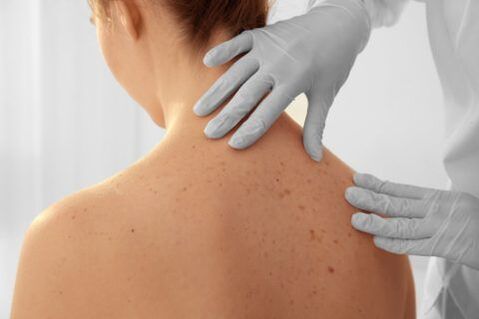
During the clinical inspection process, experts evaluate:
- The position of the patient's body, his gait, the volume of movement and passive;
- the presence of skin defects, red, peeling;
- symmetry of healthy parts and illnesses of the body;
- the presence of muscle spasm;
- irradiation area of pain;
- The presence of pain, temperature and other sensitive types.
In the process of X -ray, each spine to better visualize is individually studied.The image is taken directly, the side and (as directed) of the two skewers.To evaluate the stage and severity of degenerative changes-Dystrophic, the X-rays of the X-rays of the osteoarthritis of the spine of Zeaker are used.
Table: X -Ray of the osteoarthritis of the spine:
| Stage | Representation |
| I (+) | The changes have not been explained in Lordosis in a small number of segments |
| II (++) |
|
| III (+++) | Show changes, significantly narrowing the Intervertebral holes |
| IV (++++) | Significant narrowing the pits of Intervertebral, large Exostosis, are usually unpropeless changes |
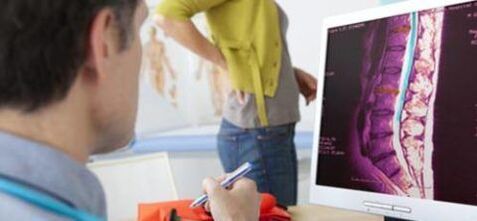
With insufficient information content of R images, patients may be more specified than modern tests (images that are targeted by one or more segments of the spine) and MRI (visual diagnosis based on the properties of electromagnetic radiation).
Treatment
First of all, the doctor explained to the patient about osteoarthritis and how to treat it.He talked about a set of measures that must be taken for a long time.
Disease therapy is taken into account the stage.In the early stages of the disease, massage, physical therapy, physiotherapy exercises are specified.But when the Dystrophic process progresses, it is advisable to use different orthopedic devices to fix the spine.Drug treatment is also necessary.
Surgical intervention is indicated for complications and with the inefficiency of conservative treatment.
Drugs
The most important tasks of treatment with pharmacological drugs are analgesic, eliminating neuritis, restoring the structure of cartilage, improving blood circulation and nutrition, preventing the development of pathology.There are some groups of drugs that may be specified in this case.
In pharmacies, they are represented in many different forms and in many types.The drug price may vary and you can always choose the most affordable price.
Table 2. The drugs are used in conservative therapy of joints:
| Pharmacological group | Therapy effect | Instructions for use |
| Chondroprotector | Slow down the process of degeneration of cartilage, contributing to its recovery. | Take 1 tablet in a month.If necessary, the treatment process is repeated. |
| NSAID | It has anesthetic effect, reduces inflammation. | Take a pills to pain.With severe pain, intramuscular injection is used. |
| B Vitamin | Improve the conductivity of nerve impulses, recover microcirculation in the area of the cartilage affected. | The treatment process with intramuscular injection is performed. |
| Musicelaxants | Relax muscles, reduce stress, facilitate pain. | Take one tablet 2 times a day. |
The drug is prescribed according to the doctor's testimony.It may not be effective, and in some cases even harm.
Physiotherapy for osteoarthritis
What to do with osteoarthritis, except for drugs, to accelerate recovery?One of the most effective methods to treat this disease is physiotherapy.
Its advantage is a selective effect for the center of the disease.Contribute physical therapy to relieve pain, eliminate inflammation and increase general immunity.With their help, relaxing muscles, metabolism and normal blood circulation.
For osteoarthritis, they are successfully used:
- Magnetic therapy;
- laser therapy;
- Shockwave therapy;
- quartz;
- electricity;
- Effect of low frequency current.
Physiotherapy does not perform if the patient is in a serious condition, with the severity of the disease, cancers and mental disorders.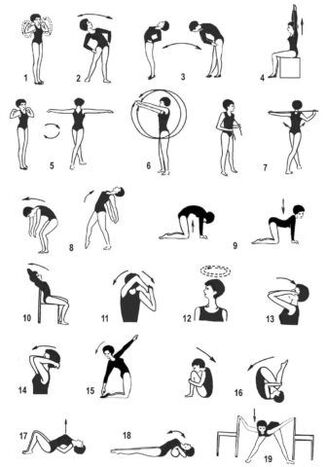 In other cases, physical therapy has a beneficial effect on the process of recovery, enhancing the effects of the drug, reducing their dosage.
In other cases, physical therapy has a beneficial effect on the process of recovery, enhancing the effects of the drug, reducing their dosage.
Medical physical education
Physical education classes are banned in the acute period of the disease.After eliminating this stage, the doctor prescribed the treatment exercises, he developed with his own instructor for each patient.
With the help of exercises, the muscle corset is enhanced, this prevents the curvature of the spine and allows you to distribute accurately and uniformly load on the vertebra.With regular physical efforts, medicinal substances enter the spine at a higher concentration than their absence.
It is necessary to participate in the guidance of an experienced guide and carefully monitor their status.With serious discomfort and pain, should stop exercising.
Prevent
Knowing what bones and joints are and its consequences, it will be helpful to think about prevention.
Preventive measures are quite simple, they are easy to implement for people who care about their health:
- prevention of injury;
- Regular physical training (swimming is very useful);
- maintain normal weight;
- No spinal load;
- Monitor the accuracy of posture;
- not in a position for a long time;
- Avoid sudden movement when lifting weights.
When completing these rules, the remission time will be long.
Osteochondrosis is a fairly serious disease.But with a timely search for a doctor and fully treated, it can prevent its destructive effect.
Questions for the doctor
Neck pain
Hello, please let me know.I am 24 years old.Over the past few months, the pain in the neck, behind the head (sometimes still given to whiskey, eyes).I also noticed a strong crispy sound in my neck, tingling and paralyzed, tongue and sky.
I suspect osteoarthritis, because both my mother and grandmother from youth were tormented with similar symptoms.Where to start the exam?And another question: Can I go to the rhythm gymnastics?
Create a R-Scheme (CT) and Doppler stores of the ships of the head and neck.You may have developed vertebral artery syndrome based on the platform of cervical joint disease.Another plan for diagnosis and treatment can only be given after obtaining the results of these tests.
It is better not to visit Aerobics.
Lumbar Osteochondrosis
For seven years, I was tortured with the lower back, the seriousness of osteoarthritis was almost every 2-3 months.Inject and tablets help in a short time, and then the pain again.I work as a letter, it becomes more difficult.I am ordering disability?
Hello!The decision on the prize of the Disabilities group was raised by ITU on the basis of a comprehensive study of your situation.First you need to contact the therapist and go through an exam.
As a rule, with lumbar osteoarthritis, a group of disabilities is not displayed.Its prize is possible with the development of complications (protruding, hernia Intervertebral, etc.).But, again, I repeat, everything is the individual here.



























